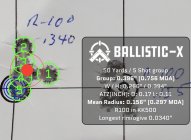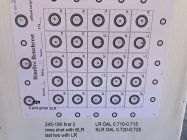I found discussions of sorting rimfire ammo by the distance from the top of the rim to the ogive on Accurate Shooter, as well as a review of Mr. Gerry Gereg's tool for doing it. I wondered how much difference it might make, so I ran a little exercise that is meant to be indicative, not conclusive, to inform whether I want to invest the effort.
I sorted 3 boxes each of 2014 vintage RWS R100, and 2022 vintage Lapua Biathlon Extreme, knowing my next match was expected to be in 25-35F weather. If you are not familiar with the device, it is measuring from an arbitrary 0 reference to evaluate relative differences in ogive length, not the absolute value of length. For both ammos, each group of 150 cartridges yielded 50 cartridges that differed from each other by no more than 0.0005" and another 50 that differed from each other by no more than 0.0010". So far, so good... Mr. Gereg's advice is to group ammo by increments of 0.001", so that's pretty consistent. The surprise came at the tails.
The newer Lapua was much tighter, with the extreme values (0.0155"/0.0190") only 0.0035" different. The older RWS had a significantly wider spread (0.0155"/0.0340) with 0.0185" difference. The latter difference was readily apparent when the cartridges were stood side by side, and since that delta translates directly into a difference in bullet engagement when the shot is released, I wondered how much difference it might make on paper.
So before the match began I warmed the clean barrel on my KK-500 (previously tuned for Lapua Biathlon Extreme) with several rounds of Tenex, then shot a five shot group at 50 yards with the RWS R100 with the highest sorted lengths, followed by a second group with the lowest sorted lengths. Temp was 28F, wind 5-12 mph. See photos below.
What was noteworthy to me was that there was 0.2" vertical difference between the center of the two groups at 50 yards. There are a fair number of disciplines in which that delta could be significant if it occurred randomly out of the box during competition. I for one will add this practice to my match preps.
BTW, because I know some of you can't resist asking, the third group on the right in the bottom photo is a 5 shot group with the Lapua Biathlon Extreme the rifle was tuned with, shot immediately after the R100 groups with ammo that sorted from the 0.0185" to 0.0190".



I sorted 3 boxes each of 2014 vintage RWS R100, and 2022 vintage Lapua Biathlon Extreme, knowing my next match was expected to be in 25-35F weather. If you are not familiar with the device, it is measuring from an arbitrary 0 reference to evaluate relative differences in ogive length, not the absolute value of length. For both ammos, each group of 150 cartridges yielded 50 cartridges that differed from each other by no more than 0.0005" and another 50 that differed from each other by no more than 0.0010". So far, so good... Mr. Gereg's advice is to group ammo by increments of 0.001", so that's pretty consistent. The surprise came at the tails.
The newer Lapua was much tighter, with the extreme values (0.0155"/0.0190") only 0.0035" different. The older RWS had a significantly wider spread (0.0155"/0.0340) with 0.0185" difference. The latter difference was readily apparent when the cartridges were stood side by side, and since that delta translates directly into a difference in bullet engagement when the shot is released, I wondered how much difference it might make on paper.
So before the match began I warmed the clean barrel on my KK-500 (previously tuned for Lapua Biathlon Extreme) with several rounds of Tenex, then shot a five shot group at 50 yards with the RWS R100 with the highest sorted lengths, followed by a second group with the lowest sorted lengths. Temp was 28F, wind 5-12 mph. See photos below.
What was noteworthy to me was that there was 0.2" vertical difference between the center of the two groups at 50 yards. There are a fair number of disciplines in which that delta could be significant if it occurred randomly out of the box during competition. I for one will add this practice to my match preps.
BTW, because I know some of you can't resist asking, the third group on the right in the bottom photo is a 5 shot group with the Lapua Biathlon Extreme the rifle was tuned with, shot immediately after the R100 groups with ammo that sorted from the 0.0185" to 0.0190".














